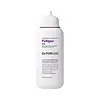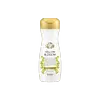What's inside
What's inside
 Key Ingredients
Key Ingredients

 Benefits
Benefits

 Concerns
Concerns

 Ingredients Side-by-side
Ingredients Side-by-side

Water
Skin ConditioningCocamidopropyl Betaine
CleansingSodium Lauroyl Methylaminopropionate
CleansingSodium Cocoyl Alaninate
Disodium Laureth Sulfosuccinate
CleansingLauryl Glucoside
CleansingCocamide Mea
EmulsifyingSodium Chloride
MaskingPolyquaternium-10
Sodium Benzoate
MaskingPEG-150 Distearate
EmulsifyingPPG-3 Myristyl Ether
EmollientCaprylyl Glycol
EmollientCitric Acid
BufferingPanthenol
Skin ConditioningSalicylic Acid
MaskingNiacinamide
SmoothingMenthol
MaskingHydrolyzed Conchiolin Protein
Skin ConditioningHydrolyzed Keratin
HumectantHydrolyzed Silk
HumectantHydrolyzed Collagen
EmollientDipropylene Glycol
HumectantPentasodium Pentetate
Acacia Senegal Gum
MaskingButylene Glycol
HumectantGlycerin
Humectant1,2-Hexanediol
Skin ConditioningPeat Water
Skin ConditioningHydroxypropyl Methylcellulose
Emulsion StabilisingCaprylic/Capric Triglyceride
MaskingLavandula Angustifolia Extract
Skin ConditioningRosmarinus Officinalis Leaf Extract
AntimicrobialChamomilla Recutita Extract
Skin ConditioningMentha Citrata Leaf Extract
AstringentPrunus Salicina Fruit Extract
AntioxidantMentha Piperita Leaf Extract
Skin ConditioningFreesia Refracta Extract
Skin ConditioningEthyl Hexanediol
SolventLecithin
EmollientPolysorbate 80
EmulsifyingCeramide NP
Skin ConditioningPotassium Sorbate
PreservativeBiotin
AntiseborrhoeicGlycine
BufferingGlutamic Acid
HumectantGlutamine
Skin ConditioningLysine
Skin ConditioningLeucine
Skin ConditioningMethionine
Skin ConditioningValine
MaskingSerine
MaskingCystine
MaskingCysteine
AntioxidantAsparagine
MaskingAspartic Acid
MaskingIsoleucine
Skin ConditioningAlanine
MaskingArginine
MaskingOrnithine
Skin ConditioningTaurine
BufferingTyrosine
MaskingThreonine
Tryptophan
MaskingPhenylalanine
MaskingProline
Skin ConditioningHistidine
HumectantAdansonia Digitata Seed Oil
EmollientCitrus Species Leaf Oil
PerfumingEucalyptus Dives Leaf Oil
PerfumingMentha Piperita Oil
MaskingSodium Hyaluronate
HumectantHydroxypropyltrimonium Hyaluronate
Hydrolyzed Hyaluronic Acid
HumectantSodium Hyaluronate Crosspolymer
HumectantSodium Acetylated Hyaluronate
HumectantEthylhexylglycerin
Skin ConditioningPentylene Glycol
Skin ConditioningParfum
MaskingHexyl Cinnamal
PerfumingWater, Cocamidopropyl Betaine, Sodium Lauroyl Methylaminopropionate, Sodium Cocoyl Alaninate, Disodium Laureth Sulfosuccinate, Lauryl Glucoside, Cocamide Mea, Sodium Chloride, Polyquaternium-10, Sodium Benzoate, PEG-150 Distearate, PPG-3 Myristyl Ether, Caprylyl Glycol, Citric Acid, Panthenol, Salicylic Acid, Niacinamide, Menthol, Hydrolyzed Conchiolin Protein, Hydrolyzed Keratin, Hydrolyzed Silk, Hydrolyzed Collagen, Dipropylene Glycol, Pentasodium Pentetate, Acacia Senegal Gum, Butylene Glycol, Glycerin, 1,2-Hexanediol, Peat Water, Hydroxypropyl Methylcellulose, Caprylic/Capric Triglyceride, Lavandula Angustifolia Extract, Rosmarinus Officinalis Leaf Extract, Chamomilla Recutita Extract, Mentha Citrata Leaf Extract, Prunus Salicina Fruit Extract, Mentha Piperita Leaf Extract, Freesia Refracta Extract, Ethyl Hexanediol, Lecithin, Polysorbate 80, Ceramide NP, Potassium Sorbate, Biotin, Glycine, Glutamic Acid, Glutamine, Lysine, Leucine, Methionine, Valine, Serine, Cystine, Cysteine, Asparagine, Aspartic Acid, Isoleucine, Alanine, Arginine, Ornithine, Taurine, Tyrosine, Threonine, Tryptophan, Phenylalanine, Proline, Histidine, Adansonia Digitata Seed Oil, Citrus Species Leaf Oil, Eucalyptus Dives Leaf Oil, Mentha Piperita Oil, Sodium Hyaluronate, Hydroxypropyltrimonium Hyaluronate, Hydrolyzed Hyaluronic Acid, Sodium Hyaluronate Crosspolymer, Sodium Acetylated Hyaluronate, Ethylhexylglycerin, Pentylene Glycol, Parfum, Hexyl Cinnamal
Water
Skin ConditioningCyclopentasiloxane
EmollientCetyl Alcohol
EmollientStearyl Alcohol
EmollientStearamidopropyl Dimethylamine
EmulsifyingParfum
MaskingBrassica Napus Seed Oil
EmollientGlutamic Acid
HumectantDimethicone
EmollientPersea Gratissima Oil
Skin ConditioningPanax Ginseng Root Extract
EmollientPhenoxyethanol
PreservativeHouttuynia Cordata Extract
Skin ConditioningSalicylic Acid
MaskingPanthenol
Skin ConditioningAmodimethicone
Niacinamide
SmoothingGanoderma Lucidum Extract
Skin ProtectingButylene Glycol
HumectantGinkgo Biloba Leaf Extract
Skin ConditioningDisodium EDTA
Tocopheryl Acetate
AntioxidantCetrimonium Chloride
AntimicrobialCyclotetrasiloxane
EmollientLavandula Angustifolia Flower Water
Skin ConditioningHydrolyzed Keratin
HumectantTrideceth-12
EmulsifyingCitrus Paradisi Fruit Extract
Skin ConditioningPinus Sylvestris Cone Extract
MaskingCitrus Limon Fruit Extract
MaskingArtemisia Vulgaris Extract
Skin ConditioningAlcohol
AntimicrobialPyrus Malus Fruit Extract
Skin ConditioningAloe Barbadensis Leaf Extract
EmollientCoix Lacryma-Jobi Ma-Yuen Seed Extract
Skin ConditioningCalendula Officinalis Extract
Skin ConditioningRosmarinus Officinalis Extract
AntimicrobialSalvia Officinalis Extract
AntimicrobialWater, Cyclopentasiloxane, Cetyl Alcohol, Stearyl Alcohol, Stearamidopropyl Dimethylamine, Parfum, Brassica Napus Seed Oil, Glutamic Acid, Dimethicone, Persea Gratissima Oil, Panax Ginseng Root Extract, Phenoxyethanol, Houttuynia Cordata Extract, Salicylic Acid, Panthenol, Amodimethicone, Niacinamide, Ganoderma Lucidum Extract, Butylene Glycol, Ginkgo Biloba Leaf Extract, Disodium EDTA, Tocopheryl Acetate, Cetrimonium Chloride, Cyclotetrasiloxane, Lavandula Angustifolia Flower Water, Hydrolyzed Keratin, Trideceth-12, Citrus Paradisi Fruit Extract, Pinus Sylvestris Cone Extract, Citrus Limon Fruit Extract, Artemisia Vulgaris Extract, Alcohol, Pyrus Malus Fruit Extract, Aloe Barbadensis Leaf Extract, Coix Lacryma-Jobi Ma-Yuen Seed Extract, Calendula Officinalis Extract, Rosmarinus Officinalis Extract, Salvia Officinalis Extract
Ingredients Explained
These ingredients are found in both products.
Ingredients higher up in an ingredient list are typically present in a larger amount.
Butylene Glycol (or BG) is used within cosmetic products for a few different reasons:
Overall, Butylene Glycol is a safe and well-rounded ingredient that works well with other ingredients.
Though this ingredient works well with most skin types, some people with sensitive skin may experience a reaction such as allergic rashes, closed comedones, or itchiness.
Learn more about Butylene GlycolGlutamic Acid is an amino acid that is found in all living organisms. Our bodies use this to help nerve cells in the brain communicate with other cells.
In cosmetics, glutamic acid is a famous humectant. It draws water from the air to your skin, keeping your skin hydrated (like hyaluronic acid).
An in-vitro study from 2024 found glutamic acid to play a role in inhibiting inflammation and thus a potential skin-soothing ingredient.
Other studies show it to be have potential wound healing, skin barrier repair, and hair growth properties.
Glutamic acid has poor solubility in water and other solvents.
Learn more about Glutamic AcidHydrolyzed Keratin is derived from keratin. Keratin is a large protein that is naturally found in our hair and skin.
Studies show keratin is able to seal broken hair cuticles, helping to prevent split ends and breakage.
As a humectant, hydrolyzed keratin helps draw moisture from the air to your hair and skin. This helps keep your skin and hair hydrated.
Learn more about Hydrolyzed KeratinNiacinamide is a multitasking form of vitamin B3 that strengthens the skin barrier, reduces pores and dark spots, regulates oil, and improves signs of aging.
And the best part? It's gentle and well-tolerated by most skin types, including sensitive and reactive skin.
You might have heard of "niacin flush", or the reddening of skin that causes itchiness. Niacinamide has not been found to cause this.
In very rare cases, some individuals may not be able to tolerate niacinamide at all or experience an allergic reaction to it.
If you are experiencing flaking, irritation, and dryness with this ingredient, be sure to double check all your products as this ingredient can be found in all categories of skincare.
When incorporating niacinamide into your routine, look out for concentration amounts. Typically, 5% niacinamide provides benefits such as fading dark spots. However, if you have sensitive skin, it is better to begin with a smaller concentration.
When you apply niacinamide to your skin, your body converts it into nicotinamide adenine dinucleotide (NAD). NAD is an essential coenzyme that is already found in your cells as "fuel" and powers countless biological processes.
In your skin, NAD helps repair cell damage, produce new healthy cells, support collagen production, strengthen the skin barrier, and fight environmental stressors (like UV and pollution).
Our natural NAD levels start to decline with age, leading to slower skin repair, visible aging, and a weaker skin barrier. By providing your skin niacinamide, you're recharging your skin's NAD levels. This leads to stronger, healthier, and younger looking skin.
Another name for vitamin B3 is nicotinamide. This vitamin is water-soluble and our bodies don't store it. We obtain Vitamin B3 from either food or skincare. Meat, fish, wheat, yeast, and leafy greens contain vitamin B3.
The type of niacinamide used in skincare is synthetically created.
Learn more about NiacinamidePanthenol is a common ingredient that helps hydrate and soothe the skin. It is found naturally in our skin and hair.
There are two forms of panthenol: D and L.
D-panthenol is also known as dexpanthenol. Most cosmetics use dexpanthenol or a mixture of D and L-panthenol.
Panthenol is famous due to its ability to go deeper into the skin's layers. Using this ingredient has numerous pros (and no cons):
Like hyaluronic acid, panthenol is a humectant. Humectants are able to bind and hold large amounts of water to keep skin hydrated.
This ingredient works well for wound healing. It works by increasing tissue in the wound and helps close open wounds.
Once oxidized, panthenol converts to pantothenic acid. Panthothenic acid is found in all living cells.
This ingredient is also referred to as pro-vitamin B5.
Learn more about PanthenolParfum is a catch-all term for an ingredient or more that is used to give a scent to products.
Also called "fragrance", this ingredient can be a blend of hundreds of chemicals or plant oils. This means every product with "fragrance" or "parfum" in the ingredients list is a different mixture.
For instance, Habanolide is a proprietary trade name for a specific aroma chemical. When used as a fragrance ingredient in cosmetics, most aroma chemicals fall under the broad labeling category of “FRAGRANCE” or “PARFUM” according to EU and US regulations.
The term 'parfum' or 'fragrance' is not regulated in many countries. In many cases, it is up to the brand to define this term.
For instance, many brands choose to label themselves as "fragrance-free" because they are not using synthetic fragrances. However, their products may still contain ingredients such as essential oils that are considered a fragrance by INCI standards.
One example is Calendula flower extract. Calendula is an essential oil that still imparts a scent or 'fragrance'.
Depending on the blend, the ingredients in the mixture can cause allergies and sensitivities on the skin. Some ingredients that are known EU allergens include linalool and citronellol.
Parfum can also be used to mask or cover an unpleasant scent.
The bottom line is: not all fragrances/parfum/ingredients are created equally. If you are worried about fragrances, we recommend taking a closer look at an ingredient. And of course, we always recommend speaking with a professional.
Learn more about ParfumSalicylic Acid (also known as beta hydroxy acid or BHA) is a well-known ingredient for treating skin that struggles with acne and clogged pores. It exfoliates both the skin's surface and deep within the pores to help clear out buildup, control oil, and reduce inflammation.
Unlike AHAs (alpha hydroxy acids), salicylic acid is oil-soluble. This allows it to penetrate into pores which makes it especially effective for treating blackheads and preventing future breakouts.
Salicylic acid is also known for its soothing properties. It has a similar structure to aspirin and can calm inflamed or irritated skin, making it a good option for acne-prone skin that is also sensitive.
Concentrations of 0.5-2% are recognized by the U.S. FDA as an over-the-counter topical acne product.
It can cause irritation and/or dryness if one's skin already has a compromised moisture barrier, so it's best to focus on repairing that before introducing this ingredient into your routine.
While salicylic acid does not increase sun sensitivity, it’s still important to wear sunscreen daily to protect your skin.
If you are looking for the ingredient called BHA or Butylated Hydroxyanisole, click here.
Learn more about Salicylic AcidWater. It's the most common cosmetic ingredient of all. You'll usually see it at the top of ingredient lists, meaning that it makes up the largest part of the product.
So why is it so popular? Water most often acts as a solvent - this means that it helps dissolve other ingredients into the formulation.
You'll also recognize water as that liquid we all need to stay alive. If you see this, drink a glass of water. Stay hydrated!
Learn more about Water